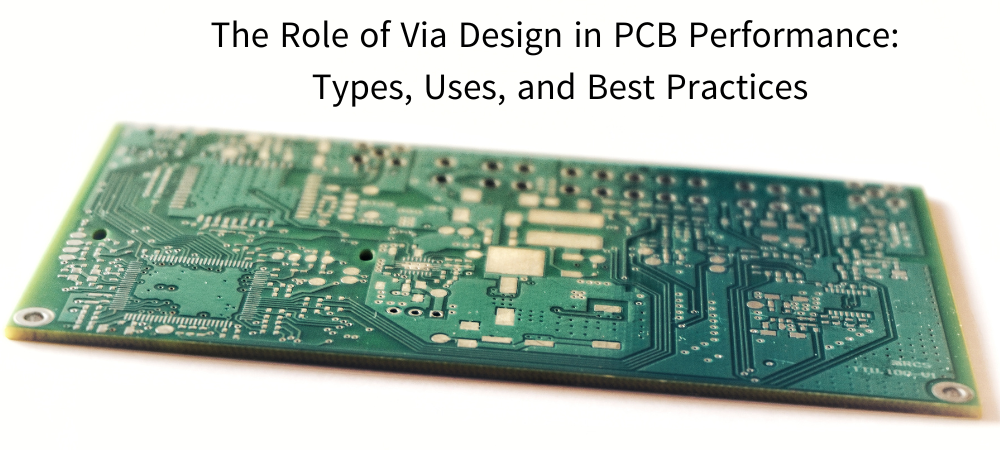
As electronic devices become faster, smaller, and more complex, the intricate design of PCBs becomes even more critical—and among their many vital features, vias stand out as some of the smallest yet most essential components.
To the naked eye, vias may seem like tiny holes scattered across the familiar green or blue surfaces of a PCB. Yet their role is anything but minor. These small, conductive pathways connect different layers of a PCB, allowing signals and power to flow seamlessly through the multi-layered structure. Without vias, the sophisticated circuitry we rely on every day would simply not be possible.
Vias ensure signal integrity, maintain electrical connectivity, and manage thermal performance. Their design, placement, and type can make or break the performance of a PCB, directly influencing the reliability and efficiency of the entire system.
Understanding the different types of vias—along with their applications and best design practices—is crucial for anyone involved in PCB layout or electrical engineering. Whether it’s through-hole, blind, or buried vias, each serves a specific purpose and comes with its own set of design considerations. Optimizing via implementation is not just about connecting layers; it’s about enabling the PCB—and the device it powers—to perform at its very best.
In this article, we’ll dive deeper into the world of PCB vias, shedding light on their critical role in modern electronics and offering insights into how thoughtful via design can significantly enhance overall system performance.
What is a via?
At its core, a via is a conductive pathway that allows electrical signals or power to pass between the layers of a multi-layer PCB. These pathways are formed by drilling small holes in the board, which are then plated with conductive material—usually copper. Without vias, a PCB would be confined to a single layer of circuitry, severely limiting its functionality and density.
But vias are more than just vertical tunnels; they are an integral part of signal routing. In high-speed or high-frequency designs, their electrical properties—such as inductance, capacitance, and impedance—must be carefully considered to avoid performance degradation.
The uses of vias in PCB design
Vias play a pivotal role in determining the PCB's performance and functionality. Their primary uses include:
- Signal transmission: Vias enable electrical signals to traverse the multiple layers of the PCB, connecting circuits and components located across different planes. This is critical in high-speed applications, where signal integrity must be preserved.
- Power distribution: Vias assist in distributing power and ground connections across the layers, ensuring that components receive stable power without interference.
- Thermal management: Heat dissipation is vital in preventing component failure. Vias filled with conductive materials, such as copper, aid in transferring heat away from critical areas.
- Space optimization: By enabling connections between layers, vias allow for more compact designs, accommodating higher component densities within smaller PCB footprints.
Types of vias and their applications
There are several types of vias, each tailored to specific PCB configurations and performance requirements (Figure 1). The most common is the through-hole via, which passes from the top layer to the bottom layer and connects every layer in between. While simple and cost-effective, through-hole vias can occupy valuable board real estate and introduce unwanted parasitics in high-speed designs.
To address these issues, designers often turn to blind and buried vias. Blind vias connect an outer layer to one or more inner layers without going all the way through the board. Buried vias are completely enclosed within the inner layers, invisible from the board's surface. These via types enable greater layer density and better control over signal integrity, albeit at a higher manufacturing cost.
Then there are microvias, which are a cornerstone of high-density interconnect (HDI) designs. These are laser-drilled and typically less than 150 microns in diameter. Because of their small size and ability to be stacked or staggered, microvias allow for tighter routing and finer pitch components, which are essential in today’s smartphones, wearables, and compact IoT devices.
Another less glamorous but highly important type is the thermal via. These are often used to conduct heat away from high-power components, transferring it to a larger copper area or even to a heatsink on another layer. Thermal management is an often-underestimated aspect of via design, but one that becomes critical in power electronics and LED boards.

Figure 1: Cross-section of a multilayer PCB showing through-hole, blind, and buried vias (Source: GlobalWell PCBA)
Impact on signal integrity and performance
Via design plays a pivotal role in maintaining signal integrity, particularly in high-speed applications where every aspect of the signal path becomes critical. The presence of vias can introduce discontinuities in the signal path, leading to reflections and impedance mismatches that may degrade signal quality. To mitigate these effects, designers often employ techniques such as back-drilling to remove unused via stubs, which can otherwise act as resonant structures and compromise signal integrity.
Thermal management (Figure 2) represents another crucial aspect where via design makes a significant impact. Thermal vias, specifically designed and placed near high-power components, create efficient pathways for heat dissipation. The strategic placement of these vias helps prevent the formation of hotspots and ensures more uniform temperature distribution across the board, ultimately enhancing the reliability and longevity of the electronic system.

Figure 2: Detail of a PCB showing thermal vias (Source: FS PCBA)
Best practices for via design
Effective via design is essential for achieving high performance, reliability, and cost-efficiency in PCBs. Below are some recommended practices.
Minimizing via count
While vias are essential for layer transitions, each one introduces parasitic inductance and capacitance. These parasitic elements can negatively impact signal integrity, especially at higher frequencies.
- Inductance: A via acts as a short length of wire, inherently possessing inductance. This inductance can cause impedance discontinuities, leading to signal reflections. The inductance of a via is approximately proportional to its length. Therefore, minimizing the number of layers changes a signal undergoes directly reduces the overall inductive impact.
- Capacitance: The barrel of the vias and the surrounding planes form a parallel plate capacitor. This capacitance can cause signal delays and affect impedance. The capacitance is influenced by the via diameter, the distance to the surrounding planes, and the dielectric constant of the PCB material.
Techniques for minimizing via count:
- Strategic layer assignment: Planning the layer stack-up and assigning signals to layers thoughtfully can reduce the need for excessive layer transitions. Grouping related signals on adjacent layers can minimize the number of vias required to connect them.
- Optimized routing strategies: Employing efficient routing techniques, such as prioritizing horizontal routing on each layer before transitioning to another, can help minimize unnecessary vertical connections.
- Component placement: Intelligent component placement can also play a role. Placing components that need to be interconnected close to each other on the same layer can reduce the need for signals to travel through multiple layers via vias.
Optimizing via placement
The placement of vias is as critical as their quantity (Figure 3). Poorly placed vias can introduce longer trace lengths, create impedance mismatches, and exacerbate signal integrity issues.
- Shortening trace lengths: Placing vias closer to the component pins they need to connect minimizes the length of the traces on each layer. Shorter traces generally exhibit better signal integrity due to reduced losses and reflections.
- Avoiding sharp bends: When a trace transitions through a via, avoid sharp 90-degree bends immediately before or after the vias. These sharp bends can cause impedance discontinuities. Instead, use gradual curves or miters to ensure a smoother signal path.
- Maintaining signal continuity: When routing differential pairs or other critical signals, ensure that the vias used for both signals are placed symmetrically and as close to each other as possible. This helps maintain signal balance and minimizes skew.
- Ground and power vias: For ground and power connections, strategically placing multiple vias can help reduce inductance and improve current carrying capacity, contributing to a more stable power delivery network. Distributing ground vias evenly can also improve signal return paths.

Figure 3: Close-up of a PCB with dense BGA layout using microvias (Source: Altium Resources)
Using appropriate via size
The dimensions of a via – its drill diameter and pad diameter – need to be carefully considered based on the application.
- Drill diameter: Smaller drill diameters generally lead to lower parasitic capacitance and a smaller footprint on the PCB layers, allowing for higher routing density. However, smaller vias might have limitations in terms of current carrying capacity and manufacturability (aspect ratio – the ratio of board thickness to drill diameter).
- Pad diameter: The pad provides the connection between the via barrel and the copper trace on each layer. The pad size needs to be large enough to ensure a reliable connection during soldering and to accommodate potential misalignments during manufacturing. However, larger pads can increase parasitic capacitance and limit routing space.
- Current carrying capacity: For power vias, the diameter of the via barrel is crucial for handling the required current without excessive voltage drop or heating. Larger diameter vias offer lower resistance.
- Signal frequency: At higher frequencies, smaller vias are often preferred to minimize signal reflections and impedance discontinuities.
Considering via stub effects
Through-hole vias that connect more layers than necessary create stubs – unused portions of the via barrel. These stubs can act as resonant structures, causing signal reflections and signal integrity problems, particularly at higher frequencies where the stub length becomes a significant fraction of the signal wavelength.
Mitigation techniques for via stub effects:
- Back drilling (controlled depth drilling): This process involves drilling out the unused portion of the via barrel from the back side of the PCB after the initial plating. Back drilling effectively eliminates or significantly reduces the length of the stub. However, it adds an extra manufacturing step and cost.
- Blind and buried vias: By their very nature, blind and buried vias do not extend through all the layers, thus eliminating the creation of stubs for the connected signals. This is a significant advantage in high-speed designs.
- Via placement optimization: Sometimes, careful layer assignment and via placement can minimize the length of stubs, even with through-hole vias. For example, if a signal transitions from layer 1 to layer 3 in a 4-layer board, placing the via such that the stub on layer 4 is short can help.
Ensuring proper impedance matching
Vias introduce impedance discontinuities in the signal path due to their inductive and capacitive characteristics. These discontinuities can cause signal reflections, which degrade signal integrity.
Techniques for improving impedance matching around vias:
- Ground plane clearance: The clearance between the via pad and the surrounding ground plane affects the via's capacitance and impedance. Optimizing this clearance can help match the impedance of the via to the trace impedance.
- Adding ground vias: Placing ground vias close to signal vias can help provide a better return path for high-frequency signals and reduce impedance discontinuities. These ground vias effectively create a more controlled electromagnetic environment around the signal via.
- Via stitching: For critical signals, especially at high frequencies, using multiple closely spaced vias (via stitching) can help create a more uniform impedance environment and improve signal integrity.
Manufacturing considerations and industry standards
The manufacturing process for PCB vias requires careful attention to industry standards and best practices. The Institute for Printed Circuits (IPC) provides comprehensive guidelines through standards such as IPC-2221 and IPC-6012, which specify requirements for via design and performance. These standards ensure consistency and reliability in PCB production while addressing critical aspects such as via protection and qualification requirements.
Modern manufacturing techniques have expanded the possibilities for via implementation, but they also present certain limitations that designers must consider. For instance, the production of blind and buried vias involves complex processes requiring precise drilling and plating techniques. The aspect ratio of vias – the relationship between hole diameter and depth – remains a critical consideration that affects both manufacturability and reliability.
05.06.2025
and get your PCBA quote within the next 10 minutes!



